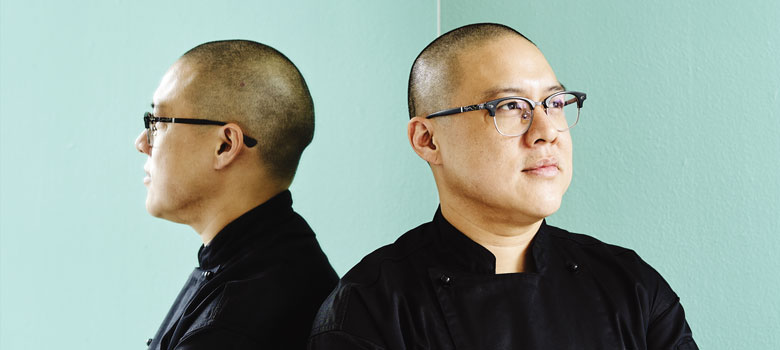
Food
Dan Hong of Mr.Wong
While Dan hong was brought up in the kitchen of his mother’s traditional vietnamese restaurant, it was the world’s great masters of east-west fusion who inspired him to forge his own future.
As a teenager, Dan Hong would sit in the kitchen of his mother’s Thanh Binh Vietnamese restaurant in Sydney’s north, rolling rice paper rolls and washing dishes, watching as she fastidiously tasted from woks and pots, adjusting their seasoning as needed.
“I took it for granted at the time,” Hong says, the beautifully appointed kitchen of his inner-city Cantonese diner Mr Wong stretching behind him. “Eating my mother’s cooking made me understand that your palate is your strongest weapon in the kitchen.”
Spending those formative years in the familial kitchen left an indelible impression on Hong, who would subsequently eschew university to pursue a chef’s traineeship.
His ensuing apprenticeship at Longrain, a now-shuttered Sydney icon beloved for chef Martin Boetz’s contemporary interpretation of classic South-East Asian flavours – those Hong had grown up with – opened his eyes to the way in which the classic, formal techniques he had learned at culinary school could be applied to the food he had grown up with.
“Working somewhere like Thanh Binh, versus somewhere like Longrain, was totally different. In my mum’s kitchen, there were no qualified chefs. They were all cooks. There was no real discipline. My mum isn’t disorganised, but she never had training as a chef.”
Formative Influences
Stints in the venerated kitchens of Marque, under chef Mark Best, and Tetsuya’s followed, the latter under the influential hand of Tetsuya Wakuda, who Hong calls “one of the godfathers of East-meets-West.” While he concedes both were fundamental in developing in him the focussed discipline a fine dining kitchen demands, it was a subsequent three-month stint in New York that would prove most formative to Hong finding his culinary voice.
“I was obsessed with molecular gastronomy at the time,” Hong says. “This was 2006, so we were all looking up to chefs like Grant Achatz (Alinea), Ferran Adria (elBulli), and Wylie Dufresne at WD50 in New York.”
He leapt at the opportunity to spend three months in the WD50 kitchen, taking a break from his posting as sous chef at Sydney’s esteemed Bentley Restaurant and Bar to immerse himself further in the world of foams, soils, spheres and other tenets of molecular gastronomy.
It had the opposite effect.
“It almost turned me against molecular gastronomy altogether. Every recipe was like a science experiment; exactly 3g of this powder, 2g of this.”
Instead, it was his post-work meals in the Lower East Side that would revolutionise Hong’s outlook on food.
“After work we would go to David Chang’s Momofuku Ssam Bar and Noodle Bar, and it blew my mind. The food was so f**king delicious.”
Then there's Ms G's where there are no rules. It's the food I grew up eating, using techniques I learned in fine dining. But I'm having fun with it.
Chang’s flavour-forward approach to combining Asian traditions with Western techniques, abandoning much of the pretence that had previously governed these ‘fusions’, struck a chord with Hong. The Korean-American chef’s respect for culinary traditions, manifested while also managing to subvert them, would be key to shaping Hong’s own signature style.
“It changed the way I looked at food. I realised I just wanted to cook the kind of food I liked eating.”
Rules and Resistance
Hong’s Momofuku-inspired approach to reinventing classic Asian dishes has since won him plenty of well-deserved plaudits, but he also understands there’s little new to the practice. The ubiquitous Australian suburban Chinese restaurant, Hong says, has been reinterpreting Cantonese dishes for decades, imbuing them with a sense of nostalgia that has become its own localised tradition.
“That’s what we try and replicate at Mr Wong,” Hong says of his 240-seat Cantonese restaurant in the heart of Sydney, one of several he heads for the Merivale Group. “I knew, for example, that I had to have fried ice cream on the menu. It’s part of that nostalgia and ingrained in our collective memory. I just made the best possible version.”
The level of tradition he stays true to, he says, depends on the brief of the venue. “At Mr. Wong, you can’t go too far because it’s a Cantonese-style restaurant, so we have the classics, as well as modern takes on classics.”
“Then there’s Ms G’s where there are no rules,” he adds of the restaurant known for dishes like cheeseburger spring rolls and Vietnamese steak tartare. “It’s the food I grew up eating, using techniques I learned in fine dining. But I’m having fun with it. Anything goes.”
While he acknowledges the importance of staying true to culinary traditions, Hong does not feel beholden to the notion of ‘authenticity’.
“You’re never going to please everyone. It’s like talking to Singaporeans about where the most authentic chicken rice in Singapore is; they’ll never agree.”
And it’s his resistance to authenticity that has kept him reluctant to follow too closely on his mother’s heels.
“If I opened a Vietnamese restaurant, I’d want it to be authentic as f**k, but I don’t think I could ever make it as good as my mother’s. I’ve never presented a Vietnamese concept to Merivale, because I feel like I wouldn’t do the food justice.”